Forums:
There are so many garden-worthy Thalictrum that they probably deserve a thread of their own.
Here is one of last year's additions to the garden, Thalictrum ichangense 'Evening Star'. (I see that it is sometimes referred to as 'Evening Star Strain', which seems sensible, seeing the considerable variation between the two plants I bought.)



Comments
ncole (not verified)
Re: Thalictrum 2011
Sat, 06/25/2011 - 1:50pmI just got one this year. Someone stepped on it at the Easter egg hunt and I thougt it was a goner, but then all of a sudden it came right back. I think it is quite different from my other ones.
Richard T. Rodich
Re: Thalictrum 2011
Sat, 06/25/2011 - 7:44pmThat one sure has a nice leaf pattern. Mine is fairly plain, from a clone that has been traded among gardeners here for at least 20 years. Nevertheless, it is very worthy.
The species stolons gently underground, Nancy. Even as a new plant, I'm not surprised that it was not killed by a misplaced foot.
cohan (not verified)
Re: Thalictrum 2011
Sun, 06/26/2011 - 5:19pmgreat leaves on this one!
Lori S. (not verified)
Re: Thalictrum 2011
Sun, 07/03/2011 - 6:21pmIt's not much in the flower department, but the foliage is very pretty and fine on Thalictrum minus:
Mark McDonough
Re: Thalictrum 2011
Sun, 07/31/2011 - 8:21amI'm a real fancy of this species. According to Wikipedia, the species has an extensive native range!..."Thalictrum minus is a perennial herb the family Ranunculaceae that is native to Yemen, Europe, Northwest Africa, Ethiopia, South Africa, Southwest Asia, and Siberia. It grows on cliffs and rocky gullies at 1,600 to 3,000 m (5,200 to 9,800 ft) elevation. It grows to 30 cm (0.98 ft) tall with erect stems and 1 cm (0.39 in) triangular leaves."
I grow a variety named T. minus 'Adiantifolium'. I don't know the standing of such a name, but plants sold under that name seem to be a particular fine form with clouds of yellowish flowers, one of my most favorite woodland plants. There was one published Thalictrum adianthifolium Besser ex Eichw., but that is not an accepted name these days.
T. minus 'Adiantifolium' in my garden, May 2006.
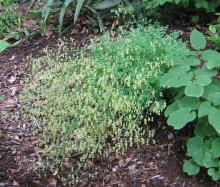
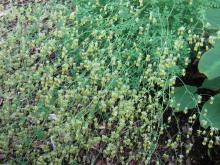
...and in May 2010
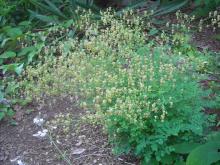
...and in May 2011. It's a very reliable plant, even surviving drought. I have never found a single seedling, even though it makes lots of seed.
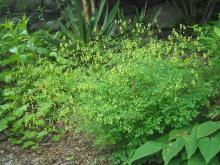
In July 09, 2011, I visited the garden of Kris Fenderson in Acworth, New Hampshire, with Chris Chadwell and his son Matthew Chadwell. In this view, I'm snapping a few photos of an impressive clump of T. flavum growing in full sun, but in a wet soil obviously suiting this plant well. Kris and Chris (left to right respectively) are in the scene as Kris leads us on a garden tour.
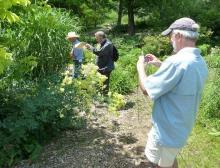
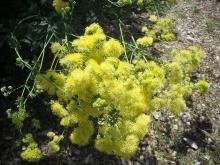
In 2010, I attended a New England Chapter NARGS tour of 3 gardens, and was taken by a bed of various Thalictrum species in the garden of Roy & Helen Herold, mostly tall thalictra type, all of which have beautiful foliage. Here's a scene showing 5 species growing in close proximity... yes, the one that looks like parsley with highly divided shiny leaves is indeed a Thalictrum; although I can't remember the species names at this point.
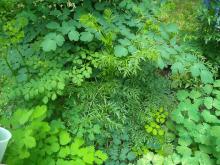
Peter George
Re: Thalictrum 2011
Sun, 07/31/2011 - 9:20amSun, part-sun, mostly shade or complete shade?
Richard T. Rodich
Re: Thalictrum 2011
Sun, 07/31/2011 - 9:12pmHard to believe you didn't make special note of that "parsley" thalictrum, Mark. It is definitely a eye catcher!
My Thalictrum flavum always leans to the sun, too. Consequently, I don't really grow it on purpose anymore, but I always have some seedlings coming up here or there...
Mark McDonough
Re: Thalictrum 2011
Sun, 07/31/2011 - 9:18pmI scribbled a note someplace about what the "parsley-leafed" Thalictrum was. I recall writing a note about what species it was, but memory fails me now, and of course I have no idea about where the notes I wrote down are. I could ask Helen or Roy to remind me of its identity.
Mark McDonough
Re: Thalictrum 2011
Sun, 08/14/2011 - 6:54pmA couple common thalictra, at opposite ends of the spectrum.
On the gigantic side, is Thalictrum rochebrunianum, growing to 8' tall. It'll grow with considerable sun, if moist enough, where it flowers more profusely. Mine are in shade, and seed around quite a bit, but it's impressive to have to look up to a plant's floral display. It literally flowers for a couple months. I purchased my plant from a nursery labeled as T. flavum :rolleyes: It is among the minority of Thalictra with showy petals (sepals).
At the opposite end of the spectrum is the rock-garden-sized T. kiusianum, only a few inches tall, also in bloom for months. It's nice having such plants in bloom in mid August.
Richard T. Rodich
Re: Thalictrum 2011
Sun, 08/14/2011 - 7:27pmThalictrum kiusianum (Kyushu Meadow Rue) is a wonderful mat former, too. Although it spreads rather slowly.
Mark McDonough
Re: Thalictrum 2011
Sun, 08/14/2011 - 7:29pmVery nice Rick, you have a much larger stand than I do, looks great! I haven't had it for years, but was given a plant last year, and even with this modest replenishment I've been enjoying the long season of bloom. The fall color is good too! I would advocate this as one of the top 100 essential rock garden plants, particularly for a half-shaded rock garden.
Lori S. (not verified)
Re: Thalictrum 2011
Sun, 08/14/2011 - 8:57pmBeauties! So well grown, all! Despite our wet summer, I think all of mine would like more water still.
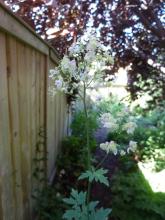
Here's Thalictrum 'Elin', apparently a hybrid of Thalictrum flavum var. glaucum and Thalictrum rochebrunianum:
Mark McDonough
Re: Thalictrum 2011
Sun, 08/14/2011 - 9:01pmVery nice... I have not heard of 'Elin', but given its parentage, I would agree that it looks quite intermediate between the two. I think most of these tall thalictrums would be happiest alongside a partly-sunny stream in a meadow setting, they do crave water.
Lori S. (not verified)
Re: Thalictrum 2011
Sun, 08/14/2011 - 9:04pmYes, indeed. This one does somewhat better in its spot... Thalictrum delavayi, one of the large-flowered ones like T. rochebrunianum though with finer foliage:
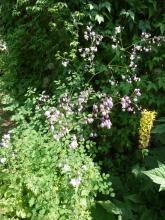
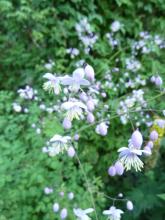
Richard T. Rodich
Re: Thalictrum 2011
Mon, 08/15/2011 - 1:44amAnd I grow both those species well, but my Elin died!
Amy Olmsted
Re: Thalictrum 2011
Tue, 08/16/2011 - 5:08pmDoes anyone have a remedy short of nuking them for the little catarpillars that completley defoliate my T. rochebrunianum? They also do a number on all my Aquilegia. I've started using systemic granules to see if that will do the trick.
Richard T. Rodich
Re: Thalictrum 2011
Tue, 08/16/2011 - 6:02pmI have plenty of problems with insect defoliation of aquilegia, but never had anything eat any of my thalictrum species or hybrids to the point of devastation, like they do with aquilegia. In fact, they are one of the most pest free plants in the garden!
I just went out and took a poll in the garden. These have absolutely no leaf insect damage in the shade garden:
T. kiusianum
T. thalictroides
T. flavum
T. dasycarpum
T. rochebrunianum Lavender Mist
T. filamentosum
T. ichangense
I also have T. aquilegifolium that is in full sun (don't ask me why 'cause I don't know). About a tenth of it's leaves have part(s) eaten.
I'm sure we would all be interested in learning the results of your use of the systemic granules. Any preliminary conclusions?
Lori S. (not verified)
Re: Thalictrum 2011
Tue, 08/16/2011 - 6:32pmIn previous gardening areas, if the leaves were being eaten by caterpillars that work outside the leaf, or even by leafminers, I found that manual squashing worked well... pretty satisfying too, if they are really bothersome. ;)
Trond Hoy
Re: Thalictrum 2011
Wed, 08/17/2011 - 12:45amI never experience defoliation of Thalictrums or Aquilegias. They are among the healthier plants here.
So is Astranta major. But I am at the lookout of something that can defoliate this one as it has become a pest plant in my garden >:(
Amy Olmsted
Re: Thalictrum 2011
Wed, 08/17/2011 - 4:47amThe defoliation happened earlier in the season and the plants have releafed out with flowers...the Aquilegia were worse, but are recovering now. I only treated the plants in pots and cut back all existing foliage. So I'll keep you up to speed if there is something good to report.
I'm using Marathon which is not available to the general public and can only be ordered through a wholesale nursery supplier, but I've been told that Bayer brand rose & flower systemic works really well on lily leaf beetles and other nasty critters, so it may work for these insects as well.
Lori S. (not verified)
Re: Thalictrum 2011
Wed, 08/17/2011 - 8:53amWell, there's always the old tried-and-true method of weeding... :) It's cheap, effective and herbicide-free. What is 90% or more of gardening anyway but weeding?